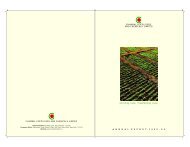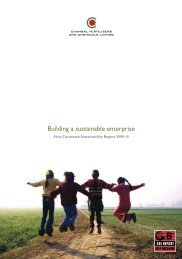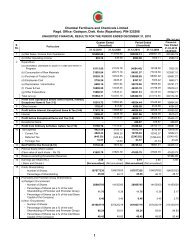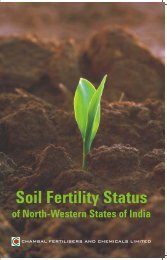Chambal_Naratives 12.cdr - Chambal Fertilisers - Home
Chambal_Naratives 12.cdr - Chambal Fertilisers - Home
Chambal_Naratives 12.cdr - Chambal Fertilisers - Home
- No tags were found...
Create successful ePaper yourself
Turn your PDF publications into a flip-book with our unique Google optimized e-Paper software.
Despite the tremendous success of the Green Revolution, which tripled the world's food supply in fourdecades, the world is now on the brink of food shortages.Indian agriculture is considered a great success story. After independence, in shortestpossible time, the country succeeded in building self-reliance in food. From 50 million tonnes a year,Indian food grain production exceeded 200 million tonnes by the turn of the century.A massive food deficit was transformed into self-sufficiency.As a nation we have to meet the challenge of growing more food for the growing population. To beginwith, India will have to raise food grain production to 250 million tonnes in the short term to keep pacewith rising demand. With obvious limits of cultivable land and irrigation facilities, we have to dependon high tech seeds, upgradation of farm practices and increased output of fertilisers to boost foodproduction.The challenge calls for supreme effort. We can do it. Our positive advantage is that we have the land,the resources, the skills and the will to perform this miracle. According to renowned agronomists, wehave the potential to produce 400 million tonnes of food grains in the near future. AsDr. Swaminathan puts it, India can become the bread basket of the world.Although food grains are important, we cannot loose sight of the untold potential of other agroproducts in the world markets. With globlisation, new avenues are opened to merchandise vegetables,fruits and dairy products in international markets. According to reports, India has vast potential forsuch products. If we succeed in seizing the new opportunities, India can aspire to be 'a foodsuperpower'.To produce more food for more people, India needs more fertilisers. Fertiliser is a capital intensiveindustry. A large fertiliser plant requires an outlay of at least USD 1 billion. Small wonder that not asingle new fertiliser plant has been set up in recent years. This can be contrasted with hugeinvestments in all other sectors.The new fertiliser policy initiated by the government recently makes a departure from the oldrestrictive policy environment. It is designed to encourage new investments and provide stability to theindustry. However, its implementation needs fine tuning. Hopefully, India's fertiliser industry can nowlook forward to an era of growth and progress in the service of the country.Your company is not just a manufacturer and marketer of fertilisers. Its vision stretches far beyond.It is an important participant in the nation's effort to achieve and maintain food security for millions ofpeople.K.K. BirlaChairmanS.K. PoddarCo-Chairman3










